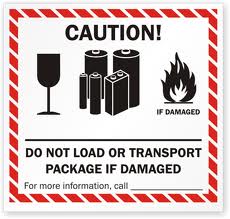
Based on my experience, one of the largest areas of non-compliance is the transportation of hazardous materials (hazmat). Many times logistics or warehouse personnel are unaware that hazardous materials are required to be packaged, unloaded, loaded, documented and shipped in a manner that is compliant with the Department of Transportation (DOT), the International Air Transportation (IATA) and International Maritime Organization (IMO) or other regulating body. The buzz about hazmat transportation became heightened in 1996 when improperly packaged oxygen generators loaded on a passenger aircraft resulted in the crash of a ValuJet 592.
Hazmat transportation has the potential to affect many companies because many items that many would not consider chemicals are hazardous when transported. One of the hazardous materials often overlooked are batteries, specifically lithium batteries found in most laptop computers and other portable digital equipment. How many times do employees simply throw battery containing equipment or batteries themselves into a cardboard box and shipped them? Over the past several years there have been many incidents involving the transportation of lithium batteries. In fact, FAA has documented 121 incidents since March of 1991 resulting from lithium batteries on aircraft. While these incidents were limited to air transportation, they highlight the concerns associated with improper transportation of hazardous materials and the importance of ensuring the appropriate personnel are knowledgeable about these requirements. Keep in mind that the applicable regulations vary based on the mode of transportation, the amount of hazmat being shipped as well as the shipping configuration of the material. During a recent project where I created procedures for shipping lithium batteries I used the International Air Transportation Association (IATA) guidance document and the Dangerous Goods Regulations for the packaging and shipping requirements of lithium batteries. These regulations are updated annually and there are changes that will be incorporated into the 2013 edition that will be released on January 1.
Do you have other resources on or questions about on hazmat transportation? If so join the conversation by making a comment below.

1 thought on “Are You Shipping Batteries?”
Comments are closed.